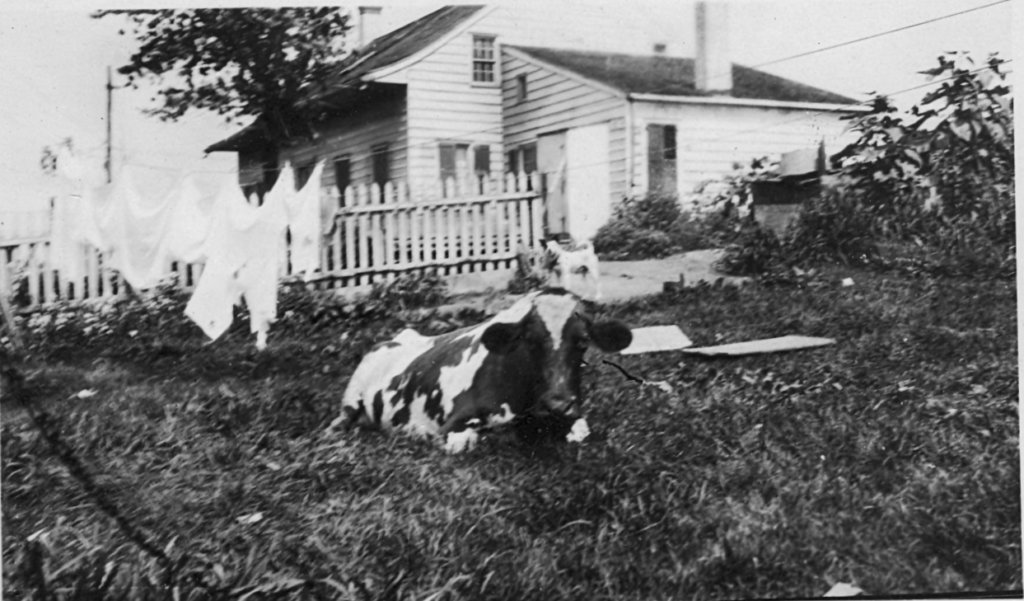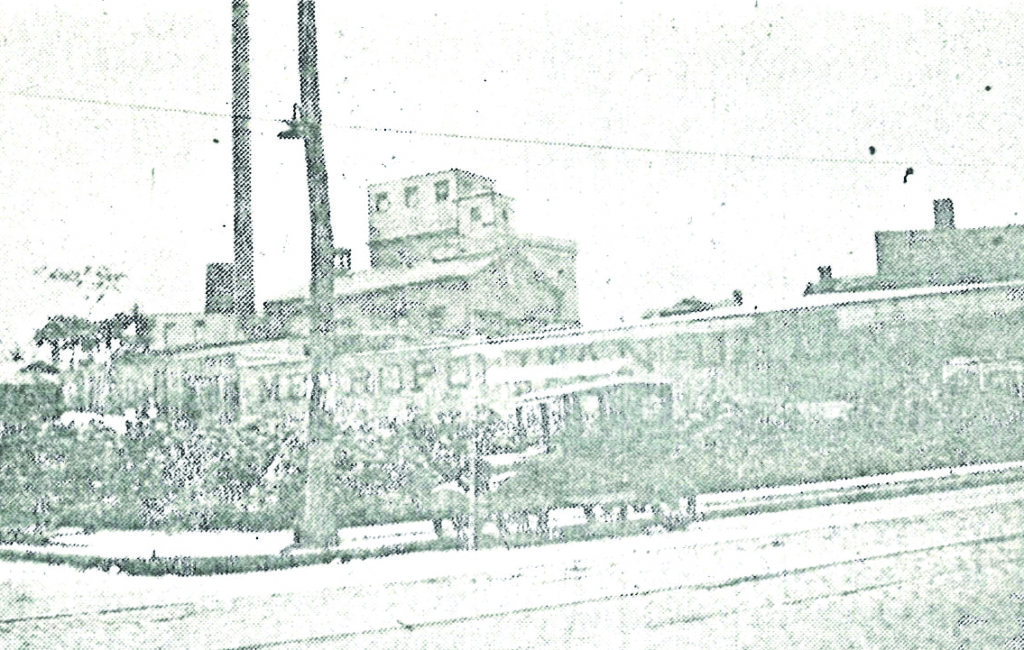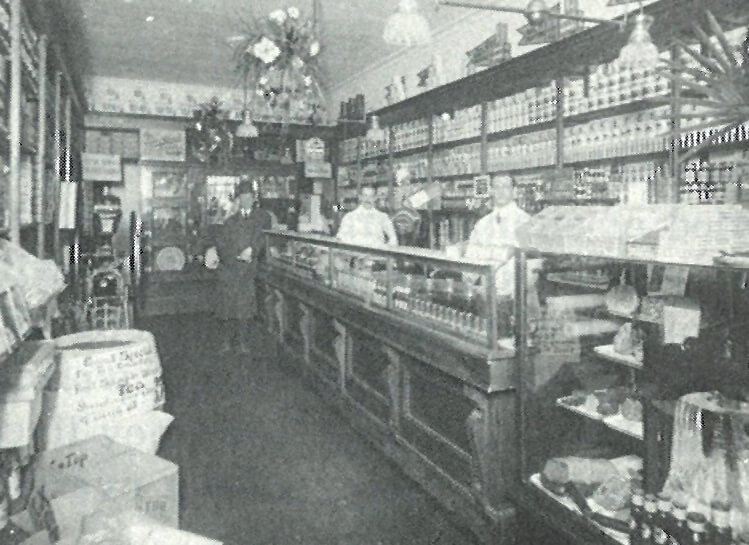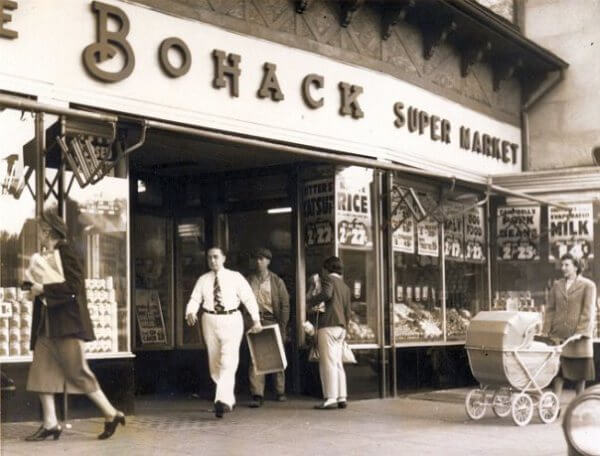Nov. 25, 2023 By The Old Timer
Years ago, Queens cooks would have had to prepare their holiday dinners without the benefit of supermarkets.
Peddlers in horse-drawn wagons made the rounds of the scattered homes of the non-farm families in the area, selling meat, fruit and vegetables. However, as the population grew, stores opened and the day of the peddler came to a close. The stores that opened were groceries, bakers, butchers, fruit and vegetable stands, ice cream parlors and candy stores.
Because of the rural nature of the Ridgewood area, there were a number of dairies, each with 50 to 60 cows, producing milk which was sold for home delivery, or to local grocers and ice cream parlors.
Who were some of the dairies of our area? Let’s take a look.

A bovine lying in the grass on a farm in early 20th-century Ridgewood (Ridgewood Times archives)
Joseph Caccioppo started a small dairy in 1901 at McKibben Street and Bushwick Avenue, and then relocated the following year to 1484 Metropolitan Ave., where he started the Grandview Dairy with 50 cows. The Grandview Dairy was on the site of the present-day Grover Cleveland High School.
He made home deliveries of “loose” milk which was poured into customers’ milk cans. In 1905, he started delivering his milk in bottles. In 1914, he installed a pasteurization unit to comply with state Board of Health requirements.

The site of the Metropolitan Dairy Company in Ridgewood (Ridgewood Times archives)
Julius Oechslein had a dairy located between Central Avenue and the Long Island Rail Road, and ran from Webster Avenue (later Olmstead Place, now 71st Street) to Madison Avenue (later Edison Place, now 71st Place) in Glendale.
George Schwartz had a dairy between Cooper and Central Avenues, which ran from Webster to Madison, with 30 cows. He sold milk at his dairy for 5 cents per quart.
Charlie Lempke, who had a dairy at what is today 78th Avenue and 78th Street in Glendale, sold milk at his farm for 3 cents per quart.
In June 1911, Charles Flugge bought the old Montauk Brewery located on the east side of Forest Avenue, just south of Metropolitan Avenue, and modernized it for his Metropolitan Dairy Company Inc. He had been associated with Henry Dobt in the milk business when, in 1892, he went into business for himself with a dairy located on Old Fresh Pond Road (now Cypress Hills Street), where the Philip Dietz coal yard was later located.
Flugge supplied milk and cream to ice cream parlors and candy stores in the area. In 1902, he organized the High Ground Dairy and then sold out in 1911 to organize the Metropolitan Dairy Company Inc.
Spices and appetizers

The interior of a deli in Ridgewood, circa 1913 (Ridgewood Times archives)
In addition to dairies, other local enterprises supplied food products.
August Bauer, who was born in Rothenfels, Bavaria, in 1853, came to America in 1879 and settled in Williamsburg. In 1883, he started selling fresh horseradish, and then added mustard and pickles. In 1903, he moved from Williamsburg to 1446 Metropolitan Ave., not too far from Caccioppo’s dairy.
The dairy may be long gone, but Bauer’s mustard remains in operation, although it relocated from Ridgewood to Long Island years ago. You can still find a jar of Bauer’s mustard at local meat markets and delis, and online at abauersmustard.com.
In 1907, Valentine Steuber opened his pickle factory at 2806 Myrtle Ave., Glendale, on the south side of the street between Commercial Street (later called Fosdick Avenue and now 69th Street) and DeBoo Place (now 68th Street). It had been a blacksmith’s shop and then Herman Sonntag’s wheelwright shop.
Today, many shoppers go to the supermarket and push a shopping cart around, grabbing whatever they need while strolling up one aisle after another. But before the age of the supermarket, our neighborhood had plenty of smaller businesses where shoppers picked up what they needed every week.
The butcher, the baker and the supermarket maker

The exterior of a Bohack supermarket in Kew Gardens in the 1940s. (Photo via Wikimedia Commons/Dumbodude)
Who were some of the stores that served our area?
Andrew Kehl, who was born in Balinghausen, Germany, in 1874, came to America and settled in Glendale in 1895. He opened a butcher shop at 2512 Myrtle Ave. and, by 1912, opened a second shop on the north side of Myrtle Avenue, between Parkview Avenue (now 80th Street) and Dry Harbor Road (now 81st Street).
By 1906, Frederick Blankenhorn had opened his butcher shop in Glendale on the corner of Cooper Avenue and Tompkins Avenue (now 70th Street).
Then there was Henry C. Bohack, who was born in Germany in 1865, came to America in 1882 and opened his first grocery store in 1887. By 1915, he had about 20 stores.
In 1924, Bohack opened the forerunner of a modern-day supermarket with a store at the northeast corner of Sprague Street (now 76th Street) and Myrtle Avenue in Glendale that sold groceries, meat, fruit and vegetables, bread and dairy products, all under one roof.
Heading to the checkout line

A 1930 ad for Bohack supermarket shows the price of ordinary food items back then (Ridgewood Times archives)
How much were the goods you wanted more than a century ago? Get ready to read and weep.
In 1906 in Ridgewood, one could find freshly ground coffee selling for 15 cents a pound. Bacon was 13 cents per pound, and butter retailed for 18 cents per pound. You could get a dozen eggs for 12 cents.
By 1909, grocers were selling loose milk for 6 cents a quart, and heavy whipping cream for 20 cents a point. Local bakers such as John Schmid, who had a bakery at the southwest corner of Myrtle Avenue and Webster Avenue (now 71st Street), sold a baker’s dozen (13) rolls or buns for 10 cents. He delivered the hot rolls and buns freshly made to his customer’s home early each morning.
In June 1912, butcher shops catering to better-paying customers sold sirloin steak for 33 cents a pound. A week earlier, it had been 30 cents; a year earlier, it was 23 cents.
By 1912, New York City was consuming 2 million quarts of milk per day, and it took 150,000 cows to supply the city. However, the farmers upstate were not very happy with the price they were getting for their milk. In the summer, they were being paid 11 cents a gallon, and in the winter, that price rose to 14 cents a gallon. The consumer at the grocery store was paying 8 cents per quart in the summer and 9 cents per quart in the winter.
In July 1917, the U.S. government published a report that showed that food prices in the previous 10 years had risen much faster than wages. They cited a railroad worker earning $1.40 a day in 1917 working a 10-hour day, six days per week. By 1916, that worker was getting $1.62.5 cents per day for a 9-hour, 40-minute day, six days per week.
In 1907, $5 bought 50 pounds of food, but by 1917, that same amount of cash only bought 35 pounds; inflation had caused a 15 percent cut in wages over that 10-year period.
Sources: the April 4 and April 11, 1985, Ridgewood Times.
***
If you have any remembrances or old photographs of “Our Neighborhood: The Way It Was” that you would like to share with our readers, please write to the Old Timer, c/o Ridgewood Times, 38-15 Bell Blvd., Bayside, NY 11361, or send an email to editorial@ridgewoodtimes.com. Any print photographs mailed to us will be carefully returned to you upon request.